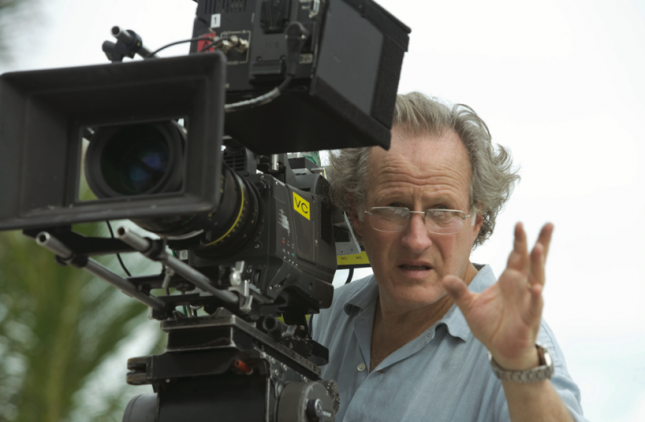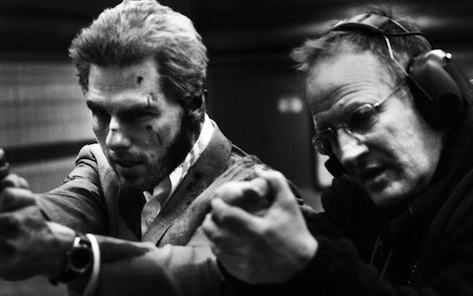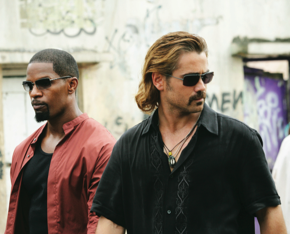
It’s still Elliott Koretz’ month here at Designing Sound and here’s a story on one of his most prolific collaborations, with director Michael Mann. In this interview, Elliott shares stories about working methods, the use of music and silence and Mann’s tireless search for perfection. Enjoy!
How did you and Michael Mann meet the first time?
My association with Michael actually goes way back to “Miami Vice” the tv show. I was an editor on it for the pilot and for two seasons. But my relationship as a supervisor started with his later tv show, “Robbery Homicide Division”. I interviewed with him and ended up getting the show. I then went on to “Collateral” and “Miami Vice”. We had a number of discussions about “Public Enemies” but ultimately I had another commitment on a different film that prevented me from doing it.
How would you describe him as a collaborator and filmmaker?
I think his track record in both tv and film speaks for itself. He has been an innovator for many years. I think one of the marks of greatness is when you are channel surfing and come across a film and even though you may have seen it countless times you stop and watch it. I find I do that with many of Michael’s films. It’s very exciting working with him. I think those of us that work with him are drawn in knowing every project has that potential for greatness. Michael is the definition of a tireless worker and the challenge is to keep up with him. He works himself harder than any director I know. His demands are many and it’s important to be mentally prepared to present him your best at all times. He has many ideas about sound and expects them to be addressed as quickly as possible. It’s very important for me to be clearly communicating this information to my crew. No question it is truly challenging working for and with him but I do understand that his intensity is in the quest for his ideal soundtrack.
You’ve collaborated on two feature films. Quite often, sound can be very tricky to talk about – how did you communicate about sound and how did your dialogue evolve throughout the process of making the two movies?
That’s a good question. Before I started designing on “Collateral” Michael called me into his office one day. He was still shooting the movie and wanted me to hear the production sound on a certain scene. It was the scene in the alleyway where Jaimie Foxx is tied to the steering wheel of his taxi and Tom Cruise comes out of a building and finds that some petty criminal has stolen his briefcase from the back seat. Tom ends up shooting the guy. The alleyway was between a tall apartment building and a large above ground parking structure. The resonant sounds of the gunshots were amazing even with blanks. Michael said, “This is the sound I want here”. I did some sweeetning to the impact of the shots but the final mix contained that same production echo. It’s really cool. I think this is a good example of Michael’s clarity in certain aspects of the sound track. He will be very clear and specific about what he is looking for. To that end he has been very generous with giving me access to do extensive field recordings for his films to facilitate that and I will speak on that subject more later on. But to address the question directly, the process I found worked best with Michael was to introduce sound elements via the Avid as early as possible. I would cut sequences, crash them down to make them Avid friendly and get that material over to the picture department to integrate into their cut. I think watching the film and hearing my material in that environment got him comfortable with the sound early in the post-production process. If he embraced it in the cutting room it really helped on the dub stage later. We would also have more traditional “spotting” sessions. My crew and I would screen reels with Michael and he would give notes along the way.

Michael Mann’s films are often very dependent on music and sound for their emotional impact. How much sound is written into his scripts?
Well the scripts were a good starting point for me to start thinking about what I needed to do. They were often very descriptive about the literal sound of the film. By that I mean very specific vehicles, weapons, and devices used in the story as well as the environments of each scene. I think the subjective design aspects of each film came more from viewing the movie and getting a sense of the flow of the picture editing.
How early on were you involved in the films? And what were your schedules?
I was fortunate that I started both “Collateral” and “Miami Vice” while they were still shooting. That gave me the ability to do a couple of very important things. First, to start getting my design sounds into the Avid very early in the process and secondly to get out to sets and have access to record. Both films were long post schedules and I think I was on for just about six months on each.
Mann actually started out working in documentaries. How important is realism to the sound design of Mann’s movies?
Very important. And that leads to my field recording. On “Collateral” we recorded every gun in the movie. We recorded the taxi. We recorded the metro trains for the film’s ending. These all were very detailed recording sessions with many mikes and multiple recorders. They were expensive to do but of incredible value to the sound of the movie. One of the more unusual outings occurred when I went out with my assistant, Bruce Barris, for an all night recording session in downtown Los Angeles. Our goal was to get recordings of the sounds one might hear at 3am. Now let me say 3am in downtown Los Angeles is quite interesting. There are many homeless people who sleep on the streets. It is an unfortunate reality and we tried to not intrude on anybody’s dignity. We recorded at a discreet distance the voices of the night. This material was used in the movie during the scenes after the first kill when Jamie realizes he is driving around with an assassin and the tension is high.

On “Miami Vice” I had the opportunity to fly down to Miami while they were shooting and do extensive recordings. We rented an airstrip and used it to record all the major autos in the film including a brand new Ferrari that wasn’t even available in the US yet. We had a few days with the speedboats and staged our own races recording bys and onboards. On one of the days at sea the lead speedboat driver (who turned out to be a reigning world champion) offered to run the boat out to Bimini for lunch. It’s 53 miles off the Miami coast and at full throttle it wouldn’t take very long to get there. Ultimately the assistant director accompanying us said no because he thought Michael wouldn’t approve. That and the fact we didn’t have our passports ended that little adventure. We also did some onboard recordings of a unique experimental airplane used in the film.
Recording the plane is an amusing story to share. Let me first describe the situation. This plane, an Adams A-500 was a very cool looking small airplane that had a featured role in a scene where our undercover heroes are smuggling some drugs into the country. Because it was so small we couldn’t be onboard while they were shooting but we did rig up our recorders and mikes and instructed the actors how to hit record and stop on the machines. The pilot (a real pilot made up to look like one of our leads) was very impatient and wanted us off the plane so he could get going. We finished what we needed to do, though not soon enough for him, and left to get to an airstrip where the plane was to fly over at what we were told treetop level for part of the smuggling sequence. We had two positions to record from at the field. My assistant was on one side of the runway and I stood in the middle but back towards the end of it. The plane came in and headed straight towards me. I stood with my shotgun mike in hand. The plane was so low I could clearly see the pilots face. Evidently he had decided that treetop level wasn’t good enough he had dropped down and came right at me just a few feet above the ground. I held my stance for as long as possible and then hit the deck. However being the professional that I am I held the mike up and got the recording. I heard later that the radio chatter from the pilot indicated he knew exactly what he was doing.
Once I edited out the “Oh Shit” it was a great close up recording.
These types of recording opportunities do not happen very often and I benefited from the fact that both movies had pretty decent budgets. I think this gives you a little insight into what Michael prioritizes when thinking about sound in his film.
As songs and music have such an important role in Mann’s movies do you collaborate more closely with the music supervisors and editors than on the usual Hollywood films where the two departments rarely meet until the mix? I read that on Collateral the song Shadow On the Sun was used already when shooting the scene with the coyotes in front of the cab.
You are correct. Music is a huge part of the sound of Michael’s movies. There was quite a bit of collaboration between our departments.We were all in the same building actually. It’s really critical to know where the music is working and in what frequencies. Then we can compliment each other and not fight for the same sonic space.
I’ve read that he’s really hands-on in the mixing process. What is he like on the dub stage?
Michael comes to the stage really well prepared. He has notebooks put together in preproduction and during the filming that have his thoughts behind every scene. He references those throughout the dub. He works very closely with the dialog mixer and is active in crafting the subtle nuances that a db up or down can help sell. I think it’s fair to say it’s an intense experience for the mixers because of this attention to detail.
I like the way you utilize silence or near-silence in subjective ways in both Collateral and Miami Vice. How many of these decisions are made during the sound editing and how many during the mixing?
A little of both I think. There are definitely moments that are designed up front for dramatic effect. Silence preceding a big action piece is quite effective. I think it draws the audience into the world we have created. And so some of that is indeed planned. But there is always room for experimentation on the dub stage. Sometimes Michael would have new ideas for us to pursue. Sometimes a change in music would lead to a new sonic direction with a scene.
At the opposite end of silence, Miami Vice had some of the most intense, hefty gun sounds I can remember – actually one of the few other sequences that equal those is the shootout in Heat. What is it about Mann and gun sounds? And how did you get those Miami Vice effects?

The guns in Vice were actually a blend of production guns, library fx and a reworking of the Collateral gun recording sessions. For the big shootout scene near the end of the film our assistants went through every production take from the shootout and build a cutting library. That is what the bed of o/s shots were made from as well as some of the close up weapons. The design was inspired by the sounds of the news footage of the North Hollywood shootout. It was very much a news/documentary type feeling. The close up guns also had some layered library sounds. Then add the ricco’s, zip bys, impacts, debris and it’s a really effective sequence.
Both Collateral and Miami Vice are very nocturnal movies. Did that influence the use of sound?
Yes. We were extremely specific with every sound in both movies particularly with the night sequences. What I mean by specific is each sound cut in these scenes was really thought out. No background recordings just rolled in. Nothing superfluous. We would ask ourselves what was the motivation behind each of these elements? What really happens at night? With the long schedule we were able to fine tune and really think out what was important. I think this process is a great way to design in general, and certainly for the night time scenes the spare nature of the tracks added a great deal of suspense to the overall mood.
Has Mann mentioned some specific inspirations for his use of sound?
Not really. I know he is quite a student of film history but our conversations were much more directed to the specifics of what he wanted for the particular film and not so much about his motivation behind it.
He seems to be extremely committed to his work. Inspiring or scary?
Yes.
Seriously, as you may have gathered and to repeat what I said before, he is most definitely a challenging guy to work for. I think he is always searching for perfect moments. He pushes himself extremely hard and you as a supervisor have to understand how to keep your crew sharp through the long hours and through the pressure packed needs to feed the stage with up to the minute conformed materials. It’s a pretty relentless pursuit for long stretches of time and you really need to be psychologically ready to be onboard for the ride.
I am very appreciative of the opportunities Michael has given me. I am very proud of the work we have done and I leave open the door to possible future collaborations.
[…] Special: Exclusive – The Michael Mann Collaboration” – read the full interview on designingsound.org, an excellent Blog on this […]